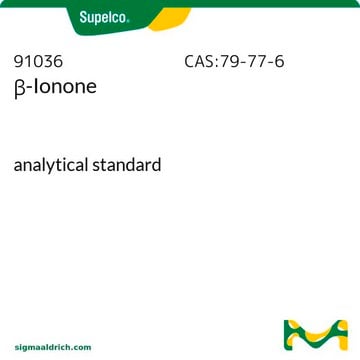44869
4-Hydroxy-2,5-dimethyl-3(2H)-furanone
analytical standard
Sinónimos:
2,5-Dimethyl-4-hydroxy-3(2H)-furanone, Furaneol, Strawberry furanone
About This Item
Productos recomendados
grade
analytical standard
Quality Level
assay
≥97.0% (GC)
shelf life
limited shelf life, expiry date on the label
technique(s)
HPLC: suitable
gas chromatography (GC): suitable
mp
73-77 °C (lit.)
application(s)
cleaning products
cosmetics
flavors and fragrances
food and beverages
personal care
format
neat
storage temp.
2-8°C
SMILES string
CC1OC(C)=C(O)C1=O
InChI
1S/C6H8O3/c1-3-5(7)6(8)4(2)9-3/h3,8H,1-2H3
InChI key
INAXVXBDKKUCGI-UHFFFAOYSA-N
¿Está buscando productos similares? Visita Guía de comparación de productos
Application
Packaging
Caution
Recommended products
signalword
Danger
hcodes
Hazard Classifications
Acute Tox. 4 Oral - Eye Dam. 1 - Skin Corr. 1B - Skin Sens. 1
Storage Class
8A - Combustible corrosive hazardous materials
wgk_germany
WGK 1
flash_point_f
Not applicable
flash_point_c
Not applicable
Choose from one of the most recent versions:
¿Ya tiene este producto?
Encuentre la documentación para los productos que ha comprado recientemente en la Biblioteca de documentos.
Nuestro equipo de científicos tiene experiencia en todas las áreas de investigación: Ciencias de la vida, Ciencia de los materiales, Síntesis química, Cromatografía, Analítica y muchas otras.
Póngase en contacto con el Servicio técnico









